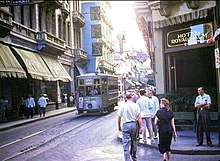White Cubans
Cubanos blancos (Spanish) | |
|---|---|
 | |
| Total population | |
| White ancestry predominates (Spaniards, Italians, Arabs and French) | |
| Regions with significant populations | |
| Majority in all of Cuba | |
| Languages | |
| Majority: Spanish Minority: Galician · Catalan | |
| Religion | |
| Majority: Christianity Minority: Irreligion | |
| Related ethnic groups | |
White Cubans (Spanish: Cubanos blancos) are Cubans who have predominantly or total European or West Asian ancestry, these stand out for having light or olive skin and self-identify as white. White Cubans are currently the largest group in Cuba.[2]
History
[edit]In 1511, Diego Velázquez de Cuéllar set out with three ships and an army of 300 men from Hispaniola to form the first Spanish settlement in Cuba, with orders from Spain to conquer the island. The settlement was at Baracoa, but the new settlers were to be greeted with stiff resistance from the local Taíno population. The Taínos were initially organized by cacique (chieftain) Hatuey, who had himself relocated from Hispaniola to escape the brutalities of Spanish rule on that island. After a prolonged guerrilla campaign, Hatuey and successive chieftains were captured and burnt alive, and within three years the Spanish had gained control of the island. In 1514, a settlement was founded in what was to become Havana.

During the eighteenth, nineteenth, and early part of the twentieth century, large waves of Canarians, Catalans, Andalusians, Castilians, and Galicians immigrated to Cuba. Many European Jews have also immigrated there, with some of them being Sephardic.[3] Between 1901 and 1958, more than a million Spaniards arrived to Cuba from Spain; many of these and their descendants left after Castro's communist regime took power. Historically, Chinese descendants in Cuba were classified as White.[4]
In 1953, the census estimated that 72.8% of Cubans were of European ancestry, mainly of Spanish origin, 12.4% of Black African ancestry, 14.5% of both Black and White ancestry (mulattos), and 0.3% of the population was of Chinese and or East Asian descent (officially called "amarilla" or "yellow" in the census). However, after the Cuban revolution, due to a combination of factors, mainly mass exodus to Miami, United States, a drastic decrease in immigration, and interracial reproduction, Cuba's demography changed. As a result, those of complete European ancestry and those of pure Black African ancestry have decreased, the mixed population has increased, and the Chinese (or East Asian) population has, for all intents and purposes, disappeared.[5][contradictory]
Demographics
[edit]| White Cubans 1774-2012 | |||||||
|---|---|---|---|---|---|---|---|
| Year | Population | % of Cuba | |||||
| 1774 | 96,440 | ||||||
| 1792 | 133,553 | ||||||
| 1817 | 238,910 | ||||||
| 1827 | 311,051 | ||||||
| 1841 | 418,291 | ||||||
| 1861 | 793,484 | ||||||
| 1877 | 981,039 | ||||||
| 1887 | 1,102,889 | ||||||
| 1899 | 1,052,397 | ||||||
| 1907 | 1,428,176 | ||||||
| 1919 | 2,088,047 | ||||||
| 1931 | 2,856,956 | ||||||
| 1943 | 3,553,312 | ||||||
| 1953 | 4,243,956 | ||||||
| 1981 | 6,415,468 | ||||||
| 2002 | 7,271,926 | ||||||
| 2012 | 7,160,399 | ||||||
| Source: Cuba census.[6] | |||||||

White people in Cuba make up 64.1% of the total population according to the 2012 census[7][8] with the majority being of diverse Spanish descent. However, after the mass exodus resulting from the Cuban Revolution in 1959, the number of white Cubans actually residing in Cuba diminished. Today various records claiming the percentage of Whites in Cuba are conflicting and uncertain; some reports (usually coming from Cuba) still report a less, but similar, pre-1959 number of 65% and others (usually from outside observers) report a 40–45%. Despite most White Cubans being of Spanish descent, many others are of French, Portuguese, Arab, German, Italian and Russian descent.[9]
The Institute for Cuban and Cuban American Studies at the University of Miami says the present Cuban population is 38% White and 62% Black/Mulatto.[10] The Minority Rights Group International says that "An objective assessment of the situation of Afro-Cubans remains problematic due to scant records and a paucity of systematic studies both pre- and post-revolution. Estimates of the percentage of people of African descent in the Cuban population vary enormously, ranging from 33.9 percent to 62 percent".[11][12]
Genetics studies
[edit]An autosomal study from 2014 found the genetic makeup in Cuba to be 72% White, 20% Black African, and 8% Native American with different proportions depending on the self-reported ancestry (White, Mixed and Black). According to this study Whites are on average 86% White, 6.7% Black African and 7.8% Native American with European ancestry ranging from 65% to 99%. 75% of whites are over 80% European and 50% are over 88% European[13] According to a study in 2011 Whites are on average 5.8% African with African ancestry ranging from 0% to 13%. 75% of whites are under 8% African and 50% are under 5% African.[14] A study from 2009 analyzed the genetic structure of the three principal ethnic groups from Havana City (209 individuals), and the contribution of parental populations to its genetic pool. A contribution from Indigenous peoples was not detectable in the studied sample.[15]
Notable White Cubans
[edit]See also
[edit]Immigrant communities in Cuba
[edit]References
[edit]- ^ "Archived copy" (PDF). www.one.cu. Archived from the original (PDF) on 3 June 2014. Retrieved 11 January 2022.
{{cite web}}: CS1 maint: archived copy as title (link) - ^ "El Color de la Piel según el Censo de Población y Viviendas" (PDF). Cuba Statistics and Information. pp. 17–18. Archived from the original (PDF) on 2022-01-21.
- ^ "In Cuba, Finding a Tiny Corner of Jewish Life". The New York Times. 4 February 2007. Retrieved 19 November 2008.
- ^ "Report on the Census of Cuba, 1899". Digital.tcl.sc.edu. p. 81. Retrieved 19 April 2022.
- ^ "El Color de la Piel según el Censo de Población y Viviendas" (PDF). Cuba Statistics and Information. pp. 8, 17–18. Archived from the original (PDF) on 21 January 2022. Retrieved 19 April 2022.
- ^ "El Color de la Piel según el Censo de Población y Viviendas" (PDF). Cuba Statistics and Information. pp. 17–18. Archived from the original (PDF) on 2022-01-21.
- ^ "2012 Cuban Census". One.cu. 28 April 2006. Archived from the original on 26 February 2011. Retrieved 23 April 2014.
- ^ "Censo en Cuba concluye que la población decrece, envejece y se vuelve cada vez más mestiza". latercera.com. Grupo Copesa. 8 November 2013. Archived from the original on 5 March 2016. Retrieved 16 July 2015.
- ^ "Etat des propriétés rurales appartenant à des Français dans l'île de Cuba". (from Cuban Genealogy Center)
- ^ "A barrier for Cuba's blacks – New attitudes on once-taboo race questions emerge with a fledgling black movement". Miami Herald. Archived from the original on 21 August 2013.
- ^ United Nations High Commissioner for Refugees. "World Directory of Minorities and Indigenous Peoples – Cuba: Afro-Cubans". Refworld. Retrieved 17 January 2018.
- ^ "World Directory of Minorities and Indigenous Peoples – Cuba: Overview". Archived from the original on 10 May 2011.
- ^ Marcheco-Teruel, B; Parra, EJ; Fuentes-Smith, E; Salas, A; Buttenschøn, HN; et al. (2014). "Cuba: Exploring the History of Admixture and the Genetic Basis of Pigmentation Using Autosomal and Uniparental Markers". PLOS Genetics. 10 (7): e1004488. doi:10.1371/journal.pgen.1004488. PMC 4109857. PMID 25058410.
- ^ Teruel, Beatriz Marcheco; Rodríguez, Juan J Llibre; McKeigue, Paul; Mesa T, Teresa Collazo; Fuentes, Evelyn; Cepero A, Adolfo Valhuerdi; Hernandez, Milagros A Guerra; Copeland JRM, John RM; Ferri, Cleusa P; Prince, Martin J (December 2011). "Interactions between genetic admixture, ethnic identity, APOE genotype and dementia prevalence in an admixed Cuban sample; a cross-sectional population survey and nested case-control study". BMC Medical Genetics. 12 (1): 43. doi:10.1186/1471-2350-12-43. PMC 3079615. PMID 21435264.
- ^ Cintado, A.; Companioni, O.; Nazabal, M.; Camacho, H.; Ferrer, A.; De Cossio, M. E. Fernandez; Marrero, A.; Ale, M.; Villarreal, A.; Leal, L.; Casalvilla, R.; Benitez, J.; Novoa, L.; Diaz-Horta, O.; Dueñas, M. (1 January 2009). "Admixture estimates for the population of Havana City". Annals of Human Biology. 36 (3): 350–360. doi:10.1080/03014460902817984. PMID 19381988. S2CID 10307820.





